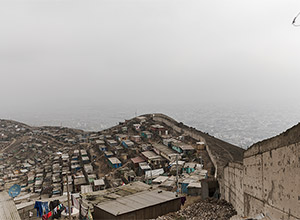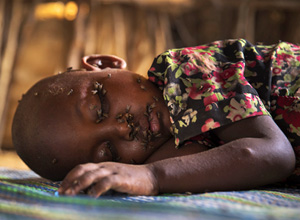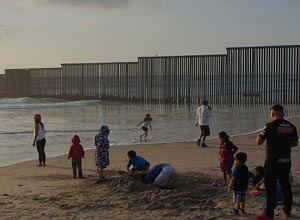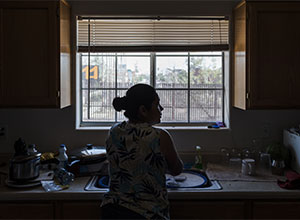persistency
At the Door of the European Continent, Trying to Enter Is a Life-Long Cycle of Uncertainties
07.ago.2017 - 02h00
{{video=3}}
Two four-meter high parallel fences stretch along 175 kilometers on the border of Serbia and Hungary to stop refugees and immigrants from entering.
The first one is a simple barbed wire fence built in September 2015. The second is a high tech barrier finished in March 2017. It is equipped with electric sensors that give those who try to pass light shocks - it also reports the intruder's exact location to guards.
There is a night vision camera and thermal sensors that detect people approaching. There are also loudspeakers that give warnings in three languages, English, Arabic and Farsi: "Warning, you are on the border of Hungary, which is property of the Hungarian government; if you damage the fence, cross illegally or attempt to pass, you will be committing a crime".
{{imagem=3}}
{{imagem=2}} [[ifo lateral / mapa fronteira com principais cidades]]]
Despite the devices, thousands of Syrians, Afghans, Pakistanis and Iraqi do not give up what they call "the game" - trying to cross the border illegally in search of a better life in the European Union.
Immigrants in groups of ten to thirty people hide in the woods for several weeks, in a place called "the jungle", only waiting for the time to cross the border. When the people smuggler calls in the middle of the night, the groups run to the border.
The plan is to split into two groups: thirty people enter from one side and twenty from the other. The police cannot catch all of them at once and some manage to get in.
The first fence was built by Hungary's nationalist First Minister, Viktor Orban, during the peak of the refugee crisis. At the time, a crowd of more than one thousand people were trying to cross into Hungary every day. The number has fallen sharply; however, today fifty people try to cross the border illegally every day.
Pakistani Rana Muzzafar Sabir, aged 28, has tried to cross from Serbia into Hungary eleven times. A month ago, during his last attempt, Hungarian police officers caught him inside Hungarian territory and beat him. Sabir says they kicked him in the eye and broke his nose. He was then deported back to Serbia. Sabir did not go to the hospital because he feared the police might show up.
{{info=1}} [[info – refugiados que chegam à europa ano a ano]]]
The Doctors Without Borders (MSF) organization provided medical care to 106 people beaten by the police on the Hungarian border from January 2016 to February 2017. In most cases, immigrants had signs of physical abuse, dog bites and sustained broken bones. Refugees report that in the winter police poured cold water on their clothes and left them out in the snow for hours, with temperatures reaching -10 °C.
Sabir left his home, in Lahore, eight months ago. He travelled through Iran, Turkey, Bulgaria and Serbia. "I am tired, but my will is not broken," says Sabir, from the "jungle" where he hides in the outskirts of Subotica, Serbia. He and ten other Pakistanis are camping at the site, where they have a tent. The area is filled with garbage and blankets on the ground.
{{mosaico=1}}
{{mosaico=2}}
{{video=1}}
{{mosaico=3}}
On an old Jeep front grill now used for cooking, the refugees make chapati bread and chicken curry with provisions brought by an NGO. They charge their mobile phones at a gas station and survive on energy drinks.
Many of them have learned some English as they made their way to the border and also by watching videos on YouTube and listening to music on their phones.
To avoid being caught, they sleep in a different place every night, often in abandoned train wagons. They return to the "jungle" to cook and wait for the people smuggler's signal, who charges 2,500 Euros for the crossing from Serbia to Austria through Hungary.
Normally they only pay if they manage to arrive in their final destination; however, some smugglers demand a non-refundable "down payment".
{{info=2}} [[[info: procedência dos imigrantes/nacionalidades]]]
{{info=3}} [[[número de refugiados em países europeus que mais os recebem]]]
"Sometimes I get very depressed, I just cannot get used to this life," says Sabir, who has an MBA in Finance and used to work as an accountant for Pepsi in Lahore. He left Pakistan because he was being persecuted by terrorist group Lashkar-e-Taiba. "And when I arrived here, many people called us terrorists."
Hameedullah Suleiman, 18, of Afghanistan, has tried to cross six times. One of the best students in his class, Suleiman was studying Aeronautical Engineering in Pakistan after receiving a scholarship. However, his parents told him to go back to his village in southern Afghanistan.
"If I had gone back, I would have had to stop studying to farm the land along with my brothers; not to mention the Taliban, which has killed many people I know," says Suleiman, who has been living in the "jungle" for a month. "Sometimes I think: what is happening to my life?"
Suleiman intends to go to London, where one of his uncles lives.
{{imagem=13}}
There are some 6,000 refugees in Serbia waiting to enter the European Union.
Many of them live in refugee camps and are on the waiting list to go to Hungary, where they will have their request for a refugee status analyzed. However, the process could last up to two years, and many will never obtain the permission to enter. Thus, they try to cross illegally.
In the Obrenovac camp, in the suburbs of Belgrade, 950 single men are living - 250 of those are underage.
Mirjana Ivanovic-Milenkovski, a spokeswoman for UNHCR, the United Nations refugee agency, says that one in every four refugees in Serbia today is underage, and many of them are unaccompanied.
In Obrenovac, refugees spent their time playing cricket or surfing the Internet on their phones. They use the camp as a dormitory. After some days there, they go back to the "jungle," and try to cross into Croatia or Hungary.
{{mosaico=4}}
{{imagem=17}}
In 2015, more than 400,000 immigrants arrived in Hungary, the door to the European Union, on their way to countries such as Germany and Sweden, which are friendlier towards refugees.
The number of immigrants plunged after the fence was built, the patrols in Turkish waters increased and the agreement between the EU and Turkey to relocate immigrants arriving in Greece to the Eurasian country was signed in 2016.
However, many refugees are stuck in the camps in Greece (more than 60,000) and Serbia (over 6,000).
A major part of Syrians and Iraqis who came in that period managed to be taken in as refugees by the EU.
Citizens of countries such as Pakistan, Bangladesh and Afghanistan, who have a harder time receiving the status of immigrants, are left behind as well as the few refugees who continue to arrive.
{{info=4}} [[[[info: principais rotas]]]]
{{imagem=1}} [[[info: renda na sérvia, hungria, alemanha, paquistão e afeganistão]]]]
"Most of them have no perspective of entering legally; the waiting list has thousands of people, but Hungary has only been allowing eight people per day to enter the transit area, while their cases are analyzed. Even so, after examining the process, most of them never get the refuge," says Stephane Moissaing, the head of the MSF mission in Serbia.
"We all know it is not a refugee crisis. Of those arriving, 95% are economic migrants, they were not in danger - they are just looking for a better life,' says Zoltan Kovacs, the spokesman of Hungarian Prime Minister Viktor Orban.
{{mosaico=5}}
"Everybody wants the European lifestyle, and the open border conveys the message that it is possible; Europe cannot carry the responsibility to take everyone in."
Robert Molnar, the mayor of Kubhekhaza, a city on the border, disagrees with Orban. He says defending that Hungary should not receive economic migrants is a selfish argument.
"Some 10% of the Hungarian population is comprised of economic migrants, people who left the country looking for better opportunities – so these Hungarians have the right to search for a better life but migrants who come here don't?," says Molnar.
Since 2012, Orban, who calls migrants "the Trojan horse of terrorism," has carried out an anti-immigration policy. The Hungarian government launched a campaign with billboards that read: "If you come to Hungary, do not take the Hungarians' jobs," and "If you come to Hungary, you must respect our culture".
{{mosaico=6}}
Orban passed laws authorizing refugees whose cases are under analysis to be kept in detention centers. These centers are shipping crates surrounded by barbed wire where refugees live for months at a time - the measure was criticized by the UNHCR and the EU.
Orban also created a police division called Border Hunters and intends to recruit 3,000 people.
The construction of the fence was widely supported by the population. Imre Csonka, a farmer in Horgos, on the Serbian border, says that he remembers the day when thousands of refugees and migrants trampled over his chrysanthemum plantation in 2015.
"They destroyed all my work," says Csonka, "The fence is necessary, the police alone were not enough to stop all those people," he says while driving a bulldozer along his lands, few meters from the fence itself.
{{video=2}}
The government of Hungary says that the costs with the fence, police patrols, transit areas and campaigns have amounted to one billion Euros.
"Hungary shouldn't receive a single migrant," says truck driver Attila Szegedi, 45, who used to be a member of the private militia organized to defend the country's borders. "Islam is not compatible with our culture," he says.
Szegedi believes the fence was a good measure; however, the government is not strict enough when punishing those who enter the country illegally.
"We want the people to see what has been happening in Germany, France and Sweden because of migrants. There is a wave of crimes, violence against women," he says.
{{video=4}}
"We don't deny that there are security problems, but the government is exaggerating and frightening people," says sociologist Mark Kékesi, the founder of Migration Aid NGO, in Szeged.
"The legitimacy of the Orban administration depends on it. This is how voters think: 'they may be corrupt, but they defend our country from these people who want to take our jobs and rape our daughters."
Activist Tibor Varga, 61, of Eastern Europe Outreach, says that the migration crisis is more complex and no solution will come only by building fences.
"Imagine the following situation: you receive a homeless family of ten people in your house. As you were a good person and helped them, they call two other ten-member families and ask you to take them in as well," says Varga, who has worked with refugees in Serbia for seven years.
"What would you do? Do you have the capacity to help all those people? There are no simple answers".
{{imagem=23}}
A few days after the meeting with Folha in the "jungle," Sabir tried to cross the border for the twelfth time - and succeeded.
Sabir walked during four days to cross Hungary – he did not have anything to eat and only drank water. He followed the GPS on his mobile phone, but when the battery died, he traded Google Maps for his instincts. He is now in a refugee camp in Austria. From there, he intends to leave for France, where he would like to live.
Hameed also crossed a few days after the meeting with the Folha news report team, but was caught by Hungarian police. He was deported and returned to a refugee camp in Belgrade and intends to attempt another crossing again soon. This time, through Croatia.






